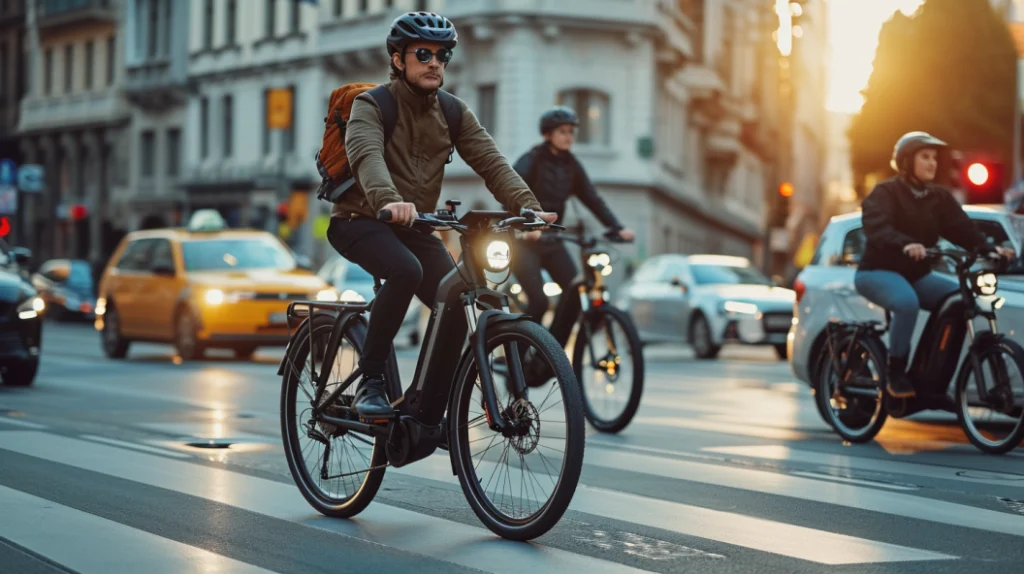Are you wondering if your new electric bicycle is street-legal? E-bikes are becoming more popular for getting around the city and commuting in a green way. It’s important to know the rules for e-bikes to ride safely and legally.
E-bikes are changing the way we travel, combining pedaling with electric help. In California, they’re treated like regular bikes, but with some special rules. There are three types of e-bikes, each with its own set of laws and limits.
Learning about E-Bike Road Rules can be complex, as they differ by place and bike type. In California, e-bikes can go on most roads and bike paths. But, there are rules about age and speed. Knowing these laws helps you ride safely and legally.
Table of Contents
Key Takeaways
- E-bikes in California are classified into three types based on their speed and motor engagement.
- Riders must be at least 16 years old to operate Class 3 e-bikes.
- E-bike motors in California are limited to 750 watts of power.
- Helmet use is mandatory for all riders on Class 3 e-bikes and those under 18 on other classes.
- E-bikes can be ridden on most roads, bike lanes, and some paths, with restrictions for Class 3 e-bikes on certain trails.
Understanding E-Bike Classifications in the USA
E-bike classifications in the United States are key for riders to know. They tell you where you can ride and what rules you must follow. The US uses a three-tier system for e-bike classes, making it simpler to understand electric bicycle laws.
Class 1 E-Bikes: Pedal-Assist Up to 20 MPH
Class 1 e-bikes help you pedal with an assist system that stops at 20 mph. They’re often allowed on bike paths and trails. This makes them the most common type.
Class 2 E-Bikes: Throttle-Assist Up to 20 MPH
Class 2 e-bikes let you move without pedaling with a throttle. They also have a 20 mph limit. But, some places limit these bikes more than Class 1 because of the throttle.
Class 3 E-Bikes: Pedal-Assist Up to 28 MPH
Class 3 e-bikes assist your pedaling up to 28 mph. They need a speedometer and are mainly for roads. In some states, riders of Class 3 e-bikes must wear helmets.
Now, 36 states use this classification system. E-bikes made after January 1, 2021, must show their class on a label. Always check local laws as they can change quickly.
| Class | Assistance Type | Max Speed | Common Use |
|---|---|---|---|
| 1 | Pedal-assist only | 20 mph | Bike paths, trails |
| 2 | Throttle-assist | 20 mph | Roads, some paths |
| 3 | Pedal-assist | 28 mph | Roads only |
Legal Status of E-Bikes
E-bike laws change from state to state in the United States. Electric bicycle regulations are not the same everywhere. By 2023, 44 states had made their own rules for e-bikes. 38 states use a 3-tiered system based on speed and power.

In most places, e-bikes don’t need to be registered, insured, or licensed. For instance, California sees e-bikes as bicycles, not motor vehicles. This means no permits or licenses are needed. Florida treats e-bikes like regular bikes, giving riders the same rights and duties as cyclists.
Some states have their own rules for e-bikes. In Hawaii, e-bikes need a $30 registration fee. Alaska requires a license to operate one. The age to ride an e-bike also varies. Kentucky has no minimum age, but Massachusetts sets it at 16.
E-bikes are changing how we move around cities, offering a green way to get around instead of cars.
Here’s how different states handle e-bike rules:
| State | License Required | Registration Required | Helmet Required | Minimum Age |
|---|---|---|---|---|
| California | No | No | Under 18 | 16 for Class 3 |
| Florida | No | No | Under 16 | No minimum |
| New York | No | No | All riders | 16 |
| Massachusetts | Yes | Yes | Under 16 | 16 |
| Hawaii | No | Yes | Under 15 | 18 to register |
With e-bikes becoming more popular, with a 23% increase in sales in 2020, it’s important to know the laws in your area.
Where You Can Ride E-Bikes
E-bikes are great for both commuting and fun rides. It’s important to know where you can ride them safely and legally.
Roads and Bike Lanes
You can ride e-bikes on most roads and bike lanes. Stick to the right lane or use the shoulders, just like regular bikes. This is a good way to get around the city and help the environment.
Sidewalks and Multi-Use Paths
Many places let e-bikes on sidewalks and paths shared with walkers. But always think about safety first. Go slower and be ready to let walkers go first.
State Parks and Trails
E-bike rules change by place. Some state parks let e-bikes on trails for regular bikes, but not all. Always check the rules before you go.
| Location | E-Bike Access | Restrictions |
|---|---|---|
| Roads | Allowed | Follow traffic laws |
| Bike Lanes | Allowed | Observe speed limits |
| Sidewalks | Often allowed | Yield to pedestrians |
| Multi-Use Paths | Often allowed | Reduce speed |
| State Parks | Varies | Check local rules |
Remember, e-bike rules can change a lot, even within states or cities. Always check the local laws before you ride to stay safe and legal.
Age Restrictions for E-Bike Riders
Electric bike laws change by state and e-bike type. It’s key to know the age rules to ride safely and legally. Let’s look at the age rules for different e-bike classes.
Class 1 and Class 2 e-bikes don’t have age limits. They help you go up to 20 mph, great for riders of all ages. But, always think about if your child can handle an e-bike before they start riding.
Class 3 e-bikes can go up to 28 mph and have tougher rules. You must be 16 or older to ride these fast e-bikes. This rule shows you need more skill to ride them safely.
Wearing a helmet is a must for all e-bike riders, especially the young ones. Kids under 18 must wear helmets on any bike, including e-bikes. For Class 3 e-bikes, everyone, no matter the age, must wear a helmet.
- No age restrictions for Class 1 and Class 2 e-bikes
- Minimum age of 16 for Class 3 e-bikes
- Helmet required for all riders under 18
- Helmet mandatory for all Class 3 e-bike riders
These are basic rules. Your area might have more rules, so always check your local electric bike laws before you ride.
E-Bike Road Rules: Safety and Etiquette
E-bikes are changing how we move around cities. It’s important to know the rules for safe e-bike use. Let’s look at the main guidelines for riding e-bikes safely.
Following Traffic Laws
E-bike riders must follow the same traffic rules as cars. This means stopping at red lights and signs, staying in your lane, and yielding when needed. In Florida, wearing helmets is not required for adults, but Emerald Coast Ebikes recommends it. They even offer free helmets with rentals.
Signaling and Communication
It’s crucial to communicate while cycling. Use hand signals to show where you’re going:
- Left turn: Extend your left arm straight out
- Right turn: Bend your left arm up at the elbow
- Stopping: Bend your left arm down at the elbow
Always make eye contact with drivers and walkers. This helps prevent accidents.
Riding Predictably
Being predictable is important for safe riding. Use bike lanes when you can, like on the Timpoochee Trail. If no lane is available, stay as far right as possible. In groups, ride single file on busy roads and keep your group small for safety.
As an e-bike user, you represent this green way of getting around. Respect local shops, be quiet in neighborhoods, and follow ‘Leave No Trace’ principles. Following these safety tips helps e-bikes stay a safe and green choice for city travel.
Helmet Requirements for E-Bike Users
E-bike helmet laws vary across the United States. They show different ways to keep cyclists safe. Some states make helmet use a must for all riders. Others protect younger cyclists more. It’s key for e-bike riders to know these laws.

In Florida, riders over 16 don’t have to wear helmets, but it’s a good idea. The Florida Department of Transportation says 40% of bike deaths are from brain injuries. This shows how important helmets are.
Let’s see what helmet rules are in other states:
- Alabama: All riders must wear helmets, no matter their age or e-bike type
- California: Helmets are needed for Class 1 & 2 riders under 18 and all Class 3 riders
- Connecticut: Riders under 16 in Class 1 & 2 and all Class 3 riders must wear helmets
- Massachusetts: All e-bike riders, no matter their age or type, must wear helmets
Some states have rules based on age. For example, Delaware and Florida say riders under 18 and 16 must wear helmets. These different laws show why riders should know the rules in their area.
Wearing a helmet is a wise choice for all e-bike users. It greatly lowers the chance of head injuries. It makes riding safer overall.
Licensing and Registration for E-Bikes
E-bike licensing rules change from state to state in the U.S. Most places see e-bikes as bicycles, making it easier for riders. In 44 states, e-bikes are classified in 3 tiers. This system helps sort out their legal status.
Each state has its own rules for e-bikes. For instance, Alaska says riders need a license for e-bikes. But in Florida, e-bikes are treated like regular bikes. So, no licenses or registration are needed there.
E-bikes have fewer legal rules than cars. In New York, Class 1 and 2 e-bikes don’t need registration or insurance. Montana also doesn’t require any registration or licenses for e-bikes.
| State | License Required | Registration Required | Minimum Age |
|---|---|---|---|
| Alaska | Yes | No | 14 |
| Hawaii | No | Yes ($30 fee) | 18 |
| Massachusetts | No | No | 16 |
| Montana | No | No | None |
| North Carolina | No | No | 16 |
Even though many states don’t need licenses or registration for e-bikes, always check your local laws. Rules can change, and it’s important to know the e-bike laws in your area.
E-Bike Speed Limits and Restrictions
E-bike speed limits are key to safe and legal riding. They are part of electric vehicle guidelines. Let’s look at the speed rules for e-bikes in the U.S.
Class-Specific Speed Limitations
E-bikes come in three classes, each with a speed limit:
- Class 1: Pedal-assist only, max speed of 20 mph
- Class 2: Throttle-assist, max speed of 20 mph
- Class 3: Pedal-assist only, max speed of 28 mph
These rules are in 38 states, making it easier to know the speed limits for e-bikes. It’s key to know your e-bike’s class to follow the right speed limits.
Adhering to Posted Speed Limits
Even with class-specific limits, always follow the speed limits on roads and paths. This is true no matter what your e-bike can do. For instance, if you’re on a Class 3 e-bike and the path has a 15 mph limit, you must go 15 mph or slower.
| E-Bike Class | Max Speed | Assist Type | Path Restrictions |
|---|---|---|---|
| Class 1 | 20 mph | Pedal-assist | None |
| Class 2 | 20 mph | Throttle-assist | None |
| Class 3 | 28 mph | Pedal-assist | Not allowed on standard bike paths |
Changing your e-bike to go faster than these limits can lead to legal trouble. Always put safety first and follow the local rules for e-bikes to ride responsibly.

Local Ordinances and E-Bike Regulations
E-bike laws vary across the United States. Municipal ordinances shape local e-bike rules. With 48 states defining e-bikes, the rules can change at the city or county level. It’s key for riders to know the laws in their area.
In Florida, some coastal areas have strict e-bike rules. Sanibel Island bans e-bikes, while Pinellas Beach doesn’t allow them on the sand. Fort Myers Beach is also thinking about similar rules. Riders should check local rules before riding their e-bikes in new places.
To keep up with e-bike laws, consider these steps:
- Contact your local police station for current information
- Visit your city or county’s official website
- Consult with local bike shops or e-bike retailers
- Join local e-bike community groups for shared knowledge
E-bike rules can change fast as more people start using them. In the last year, e-bike sales went past traditional bike sales. This has made cities rethink their e-bike policies. By knowing the local rules, you can ride your e-bike safely and follow community guidelines.
E-Bike Insurance: Requirements and Recommendations
E-bike insurance policies have different rules in the United States. Most states don’t require insurance for electric bicycles. This can save you time and money. But, it’s key to know about e-bike insurance to protect yourself and your ride.
Even though it’s not a must, getting personal liability insurance for your e-bike is smart. This coverage can help you if you’re in an accident that causes damage to property or hurt others while riding. Some insurance policies for homes or rentals might cover e-bikes, but always check with your provider. Many don’t cover motorized vehicles.
E-bike riders need to know the rules in their state. For example, in Florida, e-bikes are seen as regular bicycles. This means you can get Personal Injury Protection (PIP) benefits if you crash into a car, even without e-bike insurance.
Following safety guidelines is crucial for e-bike riders. Wearing a helmet, obeying traffic laws, and being visible can prevent accidents and claims. While you don’t have to have insurance, it’s a good way to protect yourself and enjoy your electric bicycle rides.
| State | E-Bike Insurance Requirement | Notable Regulations |
|---|---|---|
| Florida | Not required | Registration and fee payment are mandatory |
| Alaska | Not required | License required for operation |
| Hawaii | Not required | Registration and fee payment mandatory |
| Massachusetts | Not required | Helmet mandatory, minimum age 16 |
| Montana | Not required | No helmet requirement, no minimum age |
Distinguishing E-Bikes from Mopeds and Motorcycles
Electric vehicle laws are changing, and it’s important to know the differences between e-bikes, mopeds, and motorcycles. These differences affect how we follow and enforce sustainable transportation rules.
Design and Pedal Assistance
E-bikes stand out with their unique design. They look like regular bikes but have an electric motor to help you pedal. Unlike mopeds or motorcycles, you need to pedal to turn on the motor.
Speed Capabilities
Speed is a big part of eco-friendly transport rules. E-bikes usually go slower than mopeds and motorcycles:
- Class 1 and 2 e-bikes: Up to 20 mph
- Class 3 e-bikes: Up to 28 mph
- Mopeds: Generally 30-35 mph
- Motorcycles: No set limit
Legal Classifications
The legal status of these vehicles changes a lot under electric vehicle laws:
| Vehicle Type | License Required | Registration | Insurance |
|---|---|---|---|
| E-bikes | No | No | Not required |
| Mopeds | Yes | Yes | Required |
| Motorcycles | Yes | Yes | Required |
E-bikes are more like bicycles in sustainable transport policies. They offer a green and easy option for many riders.
Conclusion
E-bike road rules and electric bicycle regulations have changed a lot in the U.S. Over 30 states now see e-bikes as a good way to get around. They offer different speeds, from up to 20 mph to 28 mph, making them great for city travel.
Each state has its own rules for e-bikes. Most places treat them like regular bikes, so you don’t need a license or to register them. But, some places like Alaska and Hawaii have their own rules, like age limits and registration. Always check with your local DMV for the latest on e-bike laws where you live.
Staying safe is key for e-bike riders. Helmet laws vary, but many states say you must wear one, especially if you’re young. As e-bikes become more popular, they’re helping make cities cleaner and more efficient. By knowing the rules and focusing on safety, you can enjoy riding an e-bike and help make cities better places to live.






